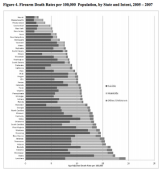TITLE: Saving lives by regulating guns: Evidence for policy (2017)
DATE:
URL: http://science.sciencemag.org/content/358/6368/1259
AUTHOR(S): Philip J. Cook and John J. Donohue
JOURNAL: Science (Vol. 358, Issue 6368)
DATE:
URL: http://science.sciencemag.org/content/358/6368/1259
AUTHOR(S): Philip J. Cook and John J. Donohue
JOURNAL: Science (Vol. 358, Issue 6368)
FINDINGS: Gun violence is a leading cause of death in the United States, where over 36,000 people were killed by gunshot in 2015 [including homicide, suicide, and accident. The gun-murder rate is 25 times as high in the United States as in other high-income nations, and the gun-suicide rate is eight times as high. Interpersonal gun violence has deleterious effects on economic development and standard of living in heavily impacted neighborhoods. [M]any aspects of the body of research on gun violence have been deemed inadequate and inconclusive by expert panels of the U.S. Centers for Disease Control and Prevention (CDC) and of the National Academies of Sciences, Engineering, and Medicine.

